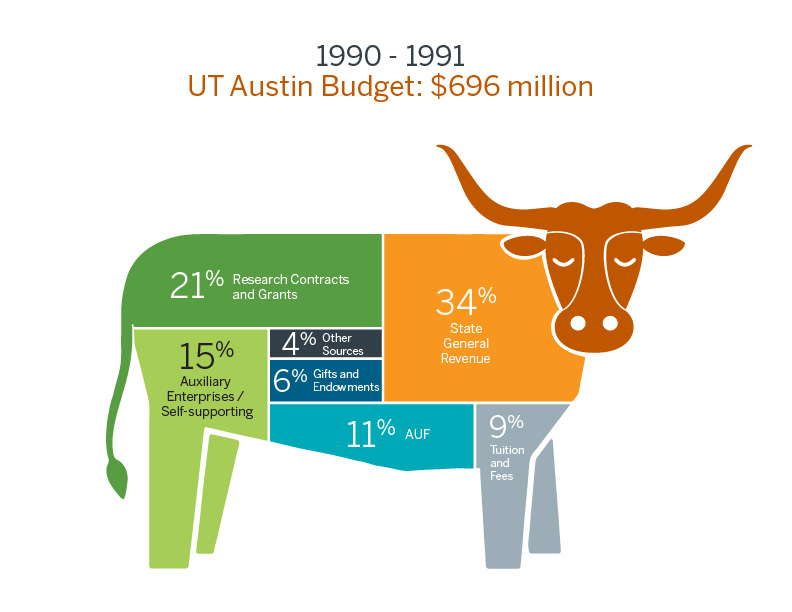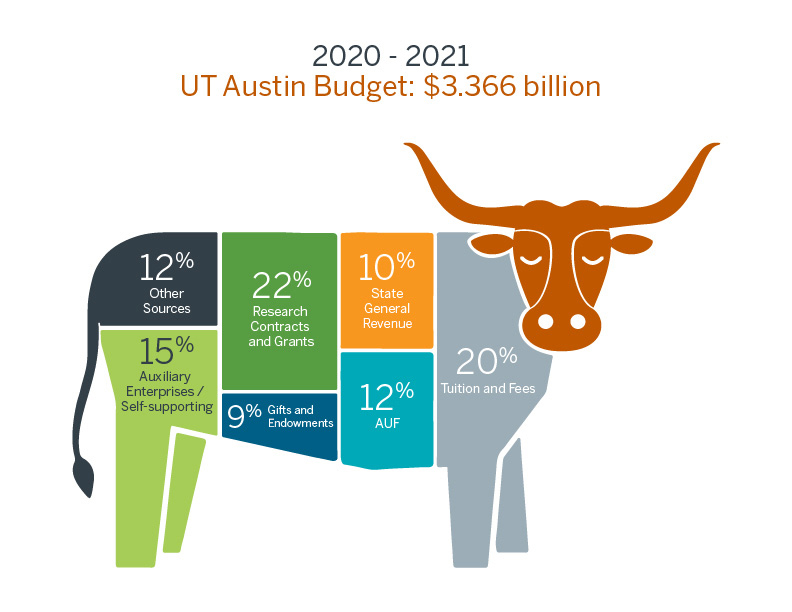Sources of Revenue
The University of Texas at Austin relies on a number of sources of revenue. Tuition, state funding and distributions from the Available University Fund comprise the vast majority of academic core funding in the University’s budget. Gifts and endowments provide additional resources greatly enhancing academic programs. Research contracts and grants support UT Austin’s research enterprise, and revenues generated by the institution’s self-supporting auxiliary enterprises fund the provision of services and activities that complete the first-class UT Austin experience.
State General Revenue
The State of Texas provides UT Austin annual funding from the State Treasury (called General Revenue) through a variety of funding formulas (primarily based on enrollment), as well as certain non-formula items. State support for UT Austin, and other public institutions of higher education in general, has declined over the last few decades, putting more pressure on other sources of revenue throughout higher education. For example, in the 1990-91 fiscal year, the State of Texas provided 34 percent of the University’s total budget. Since that time, state funding has stagnated while the University has grown, placing pressure on other funding sources. In the 2020-21 fiscal year, state General Revenue funding accounts for just over 10 percent of the total budget.
Available University Fund (AUF)
In 1876, the Texas Constitution set aside 2.1 million acres in West Texas to support The University of Texas and Texas A&M systems; these assets comprise the Permanent University Fund (PUF). Oil/gas and other mineral income are invested and a percentage of the return, along with surface income (largely grazing leases and power generation), are deposited into the Available University Fund (AUF) and distributed to both university systems. UT Austin receives a portion of these funds to support its academic programs and campus operations.
Gifts and Endowments
The University is fortunate to receive numerous gifts and endowments, thanks to the generosity of donors. Most of these endowments are dedicated to specific purposes such as scholarships and the support of faculty studying particular disciplines. Other gifts are made for specific purposes, such as the construction of new buildings.
Research Grants and Contracts
As one of the world’s leading research universities, UT Austin receives substantial funding in the form of grants and contracts from external entities, including federal, state and local governments as well as private entities. The use of these funds by the research and sponsored projects they support often are strictly spelled out in the terms of the contract or grant. Due to the qualifications placed on these revenues they are often referred to as Restricted Funds.
Auxiliary Enterprises and other Self-supporting
Auxiliary enterprises provide goods or services to students, faculty, staff, and/or the general public and charge fees directly related to the cost of the good or service. With few exceptions, UT Austin auxiliary enterprises must support their costs with their own revenue generation and are therefore regarded as self-supporting. Primary examples include Intercollegiate Athletics, University Housing & Dining, Parking and Transportation and the AT&T Hotel & Conference Center. In addition, there are other self-supporting programs within the University that may be operated from the academic or administrative side of campus.
Other Sources of Revenue
A number of other sources of revenue help support UT Austin, including budgeted balances, interest income, intellectual property income and administrative fees, among many others.

